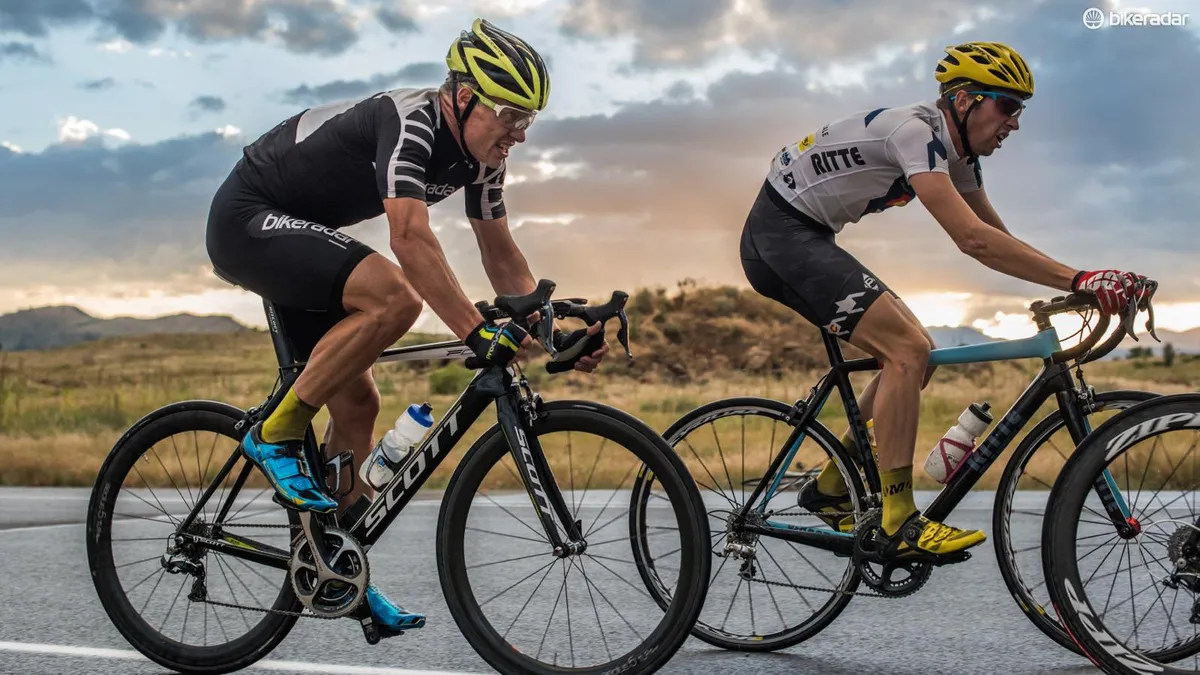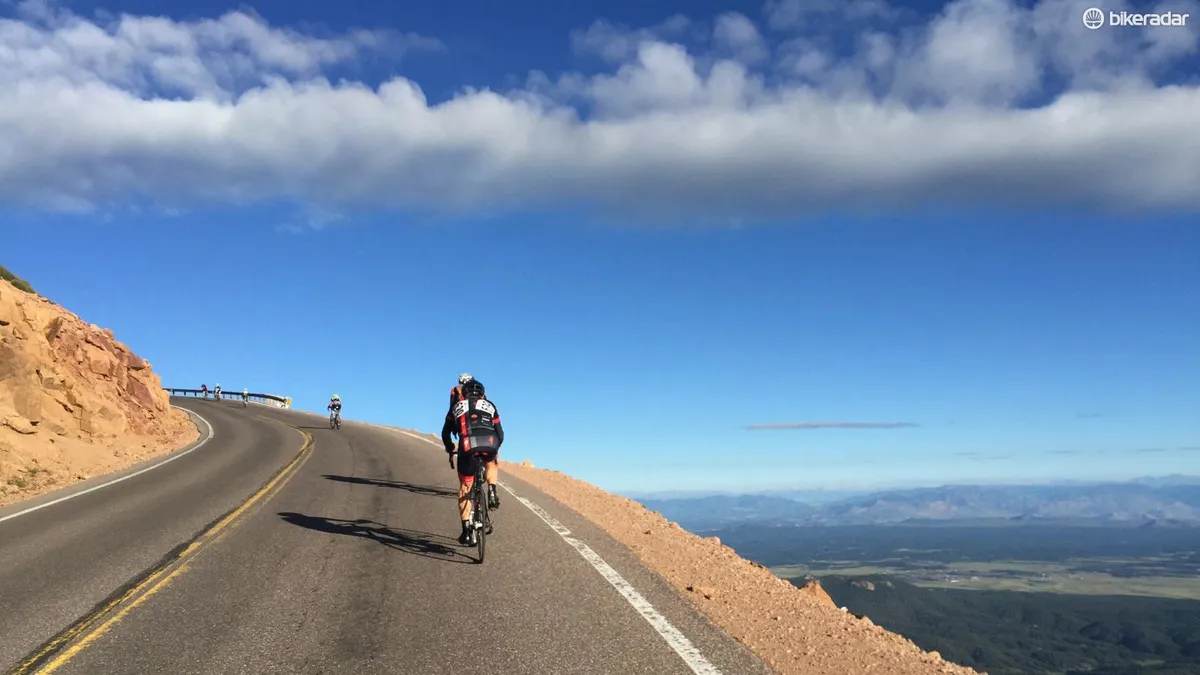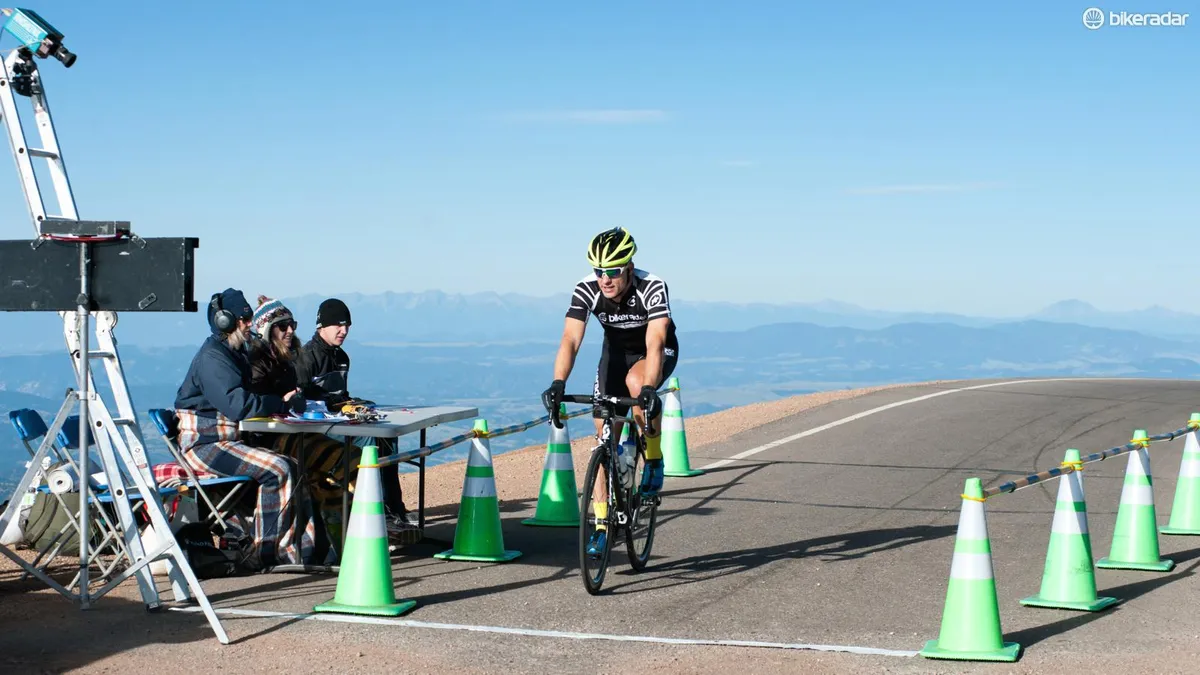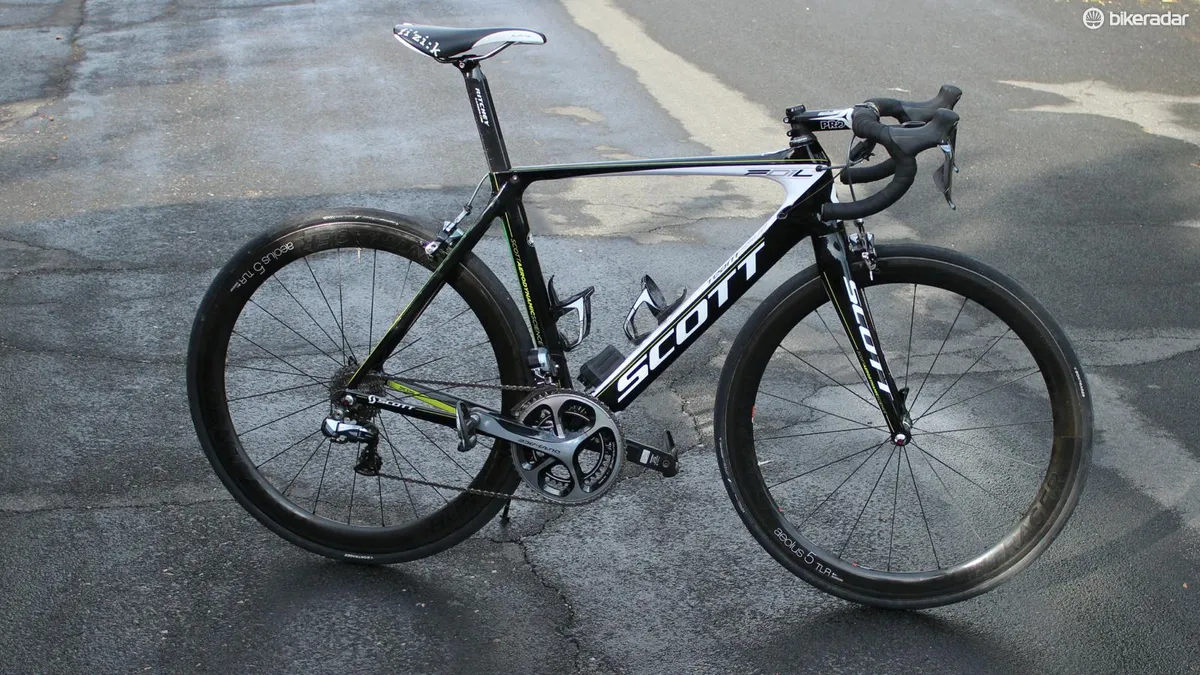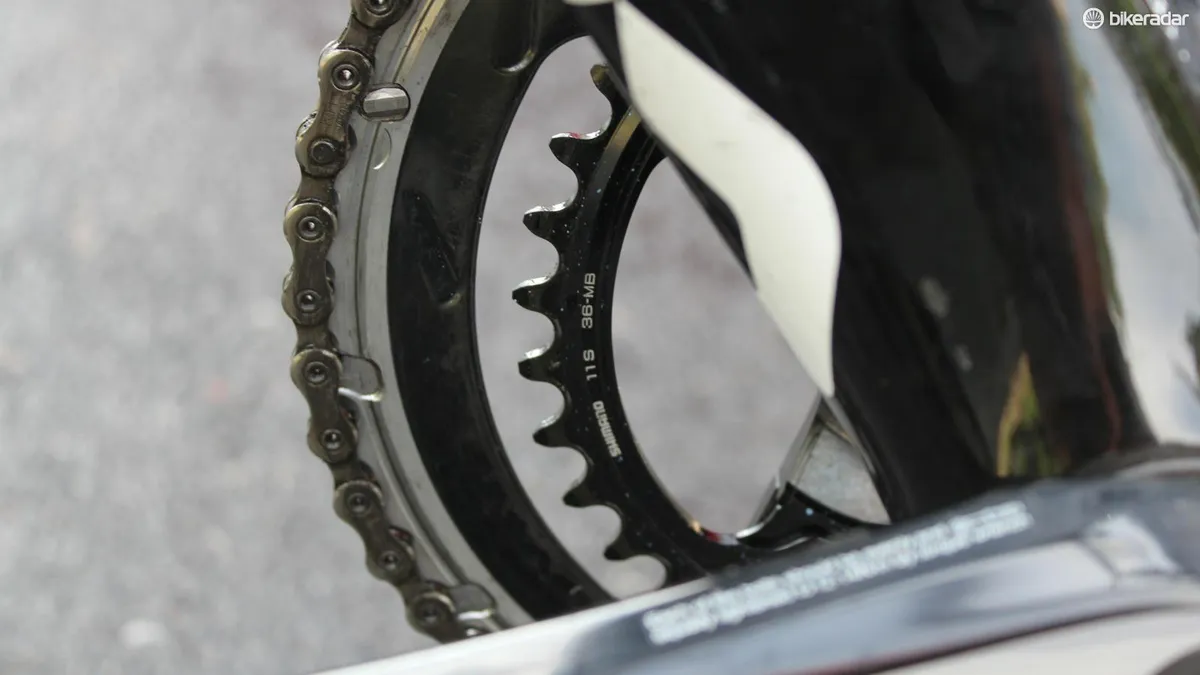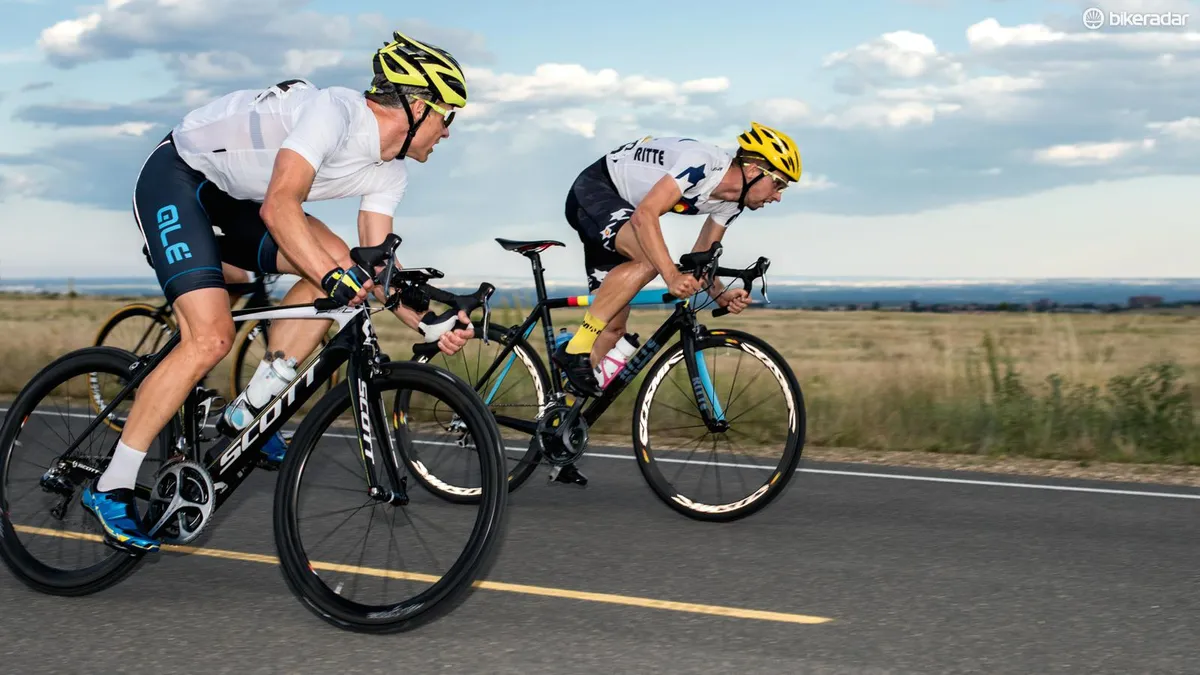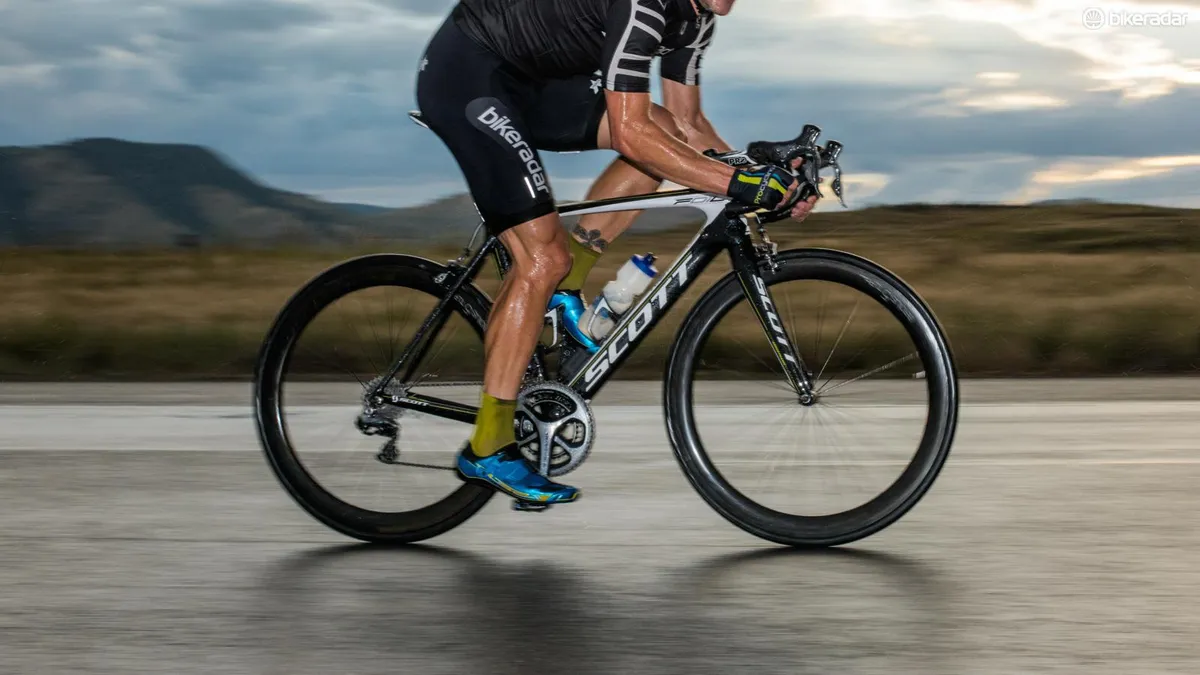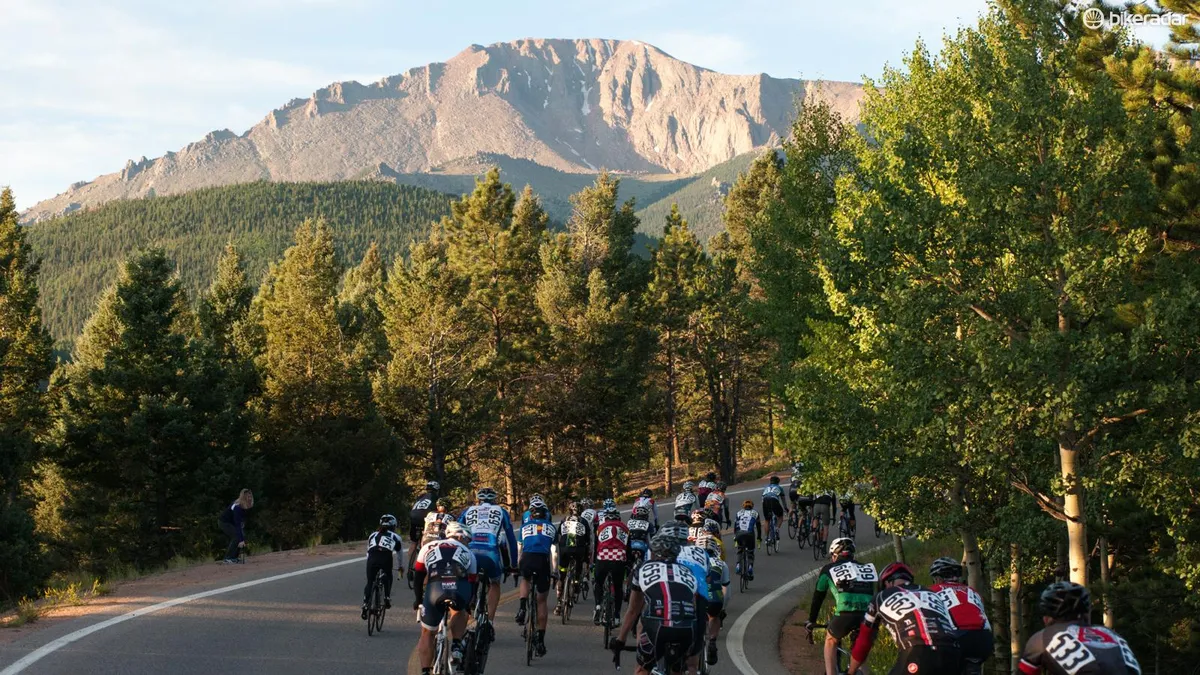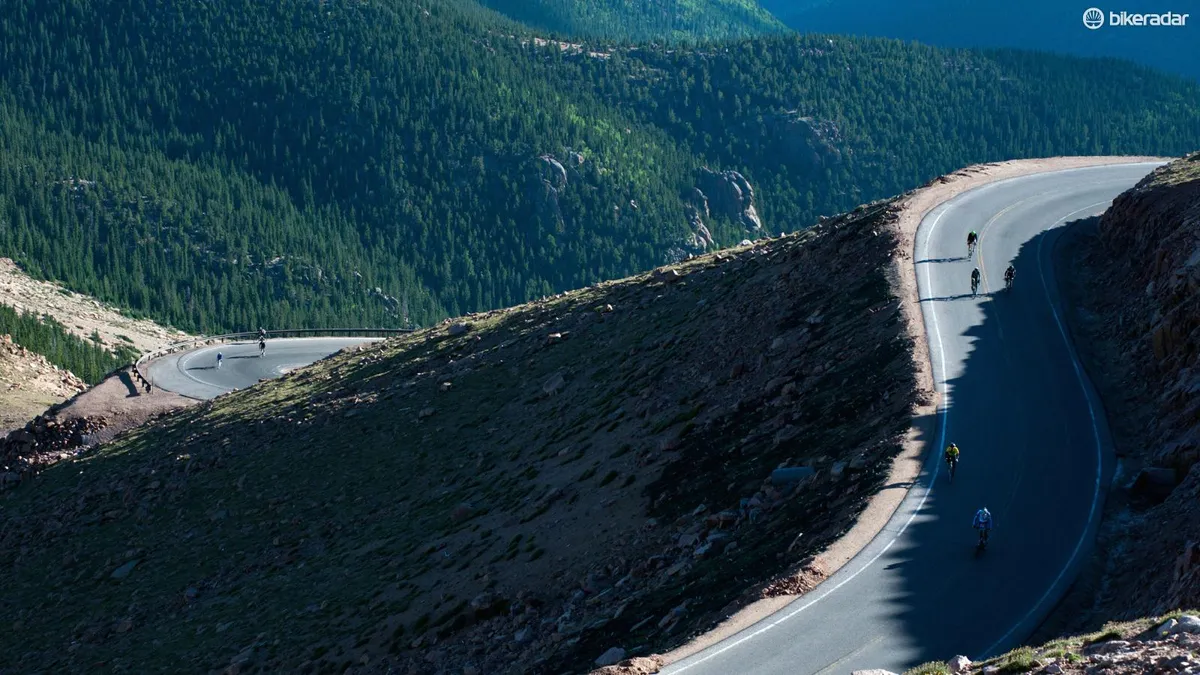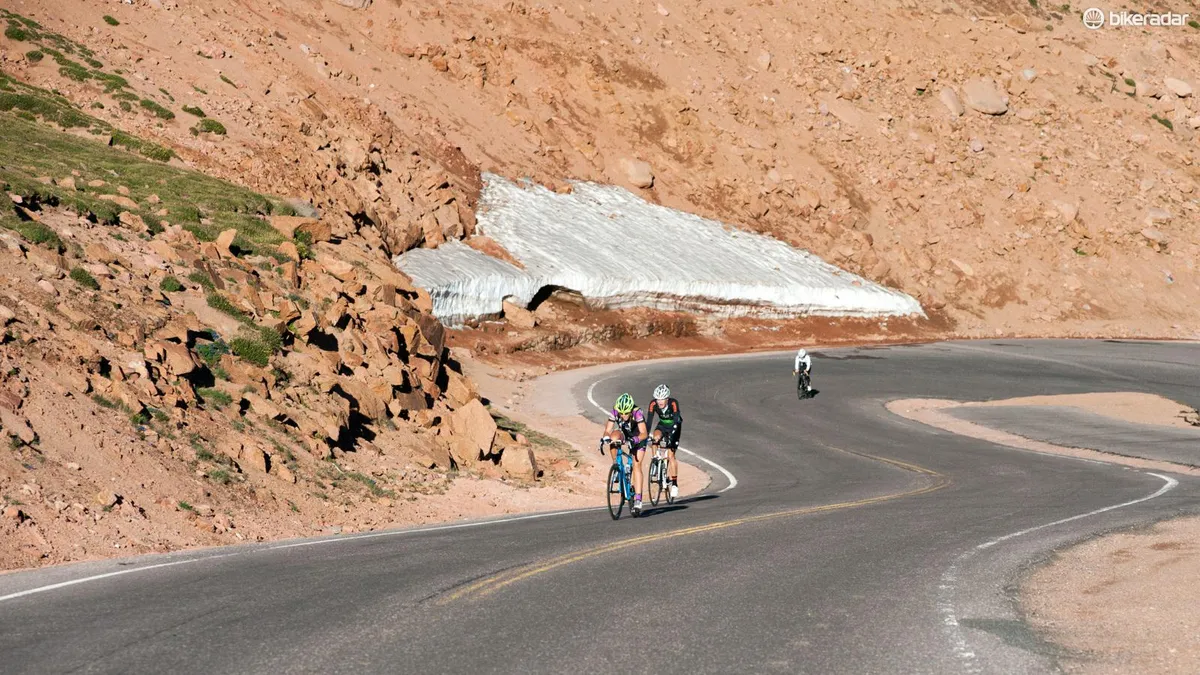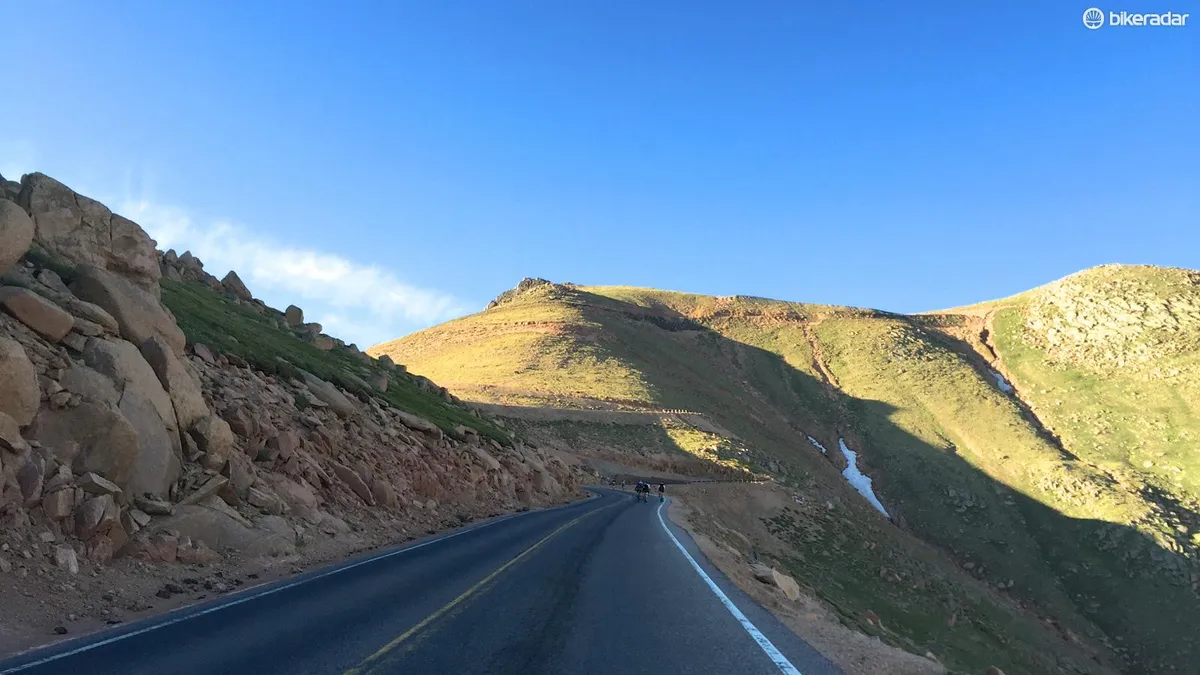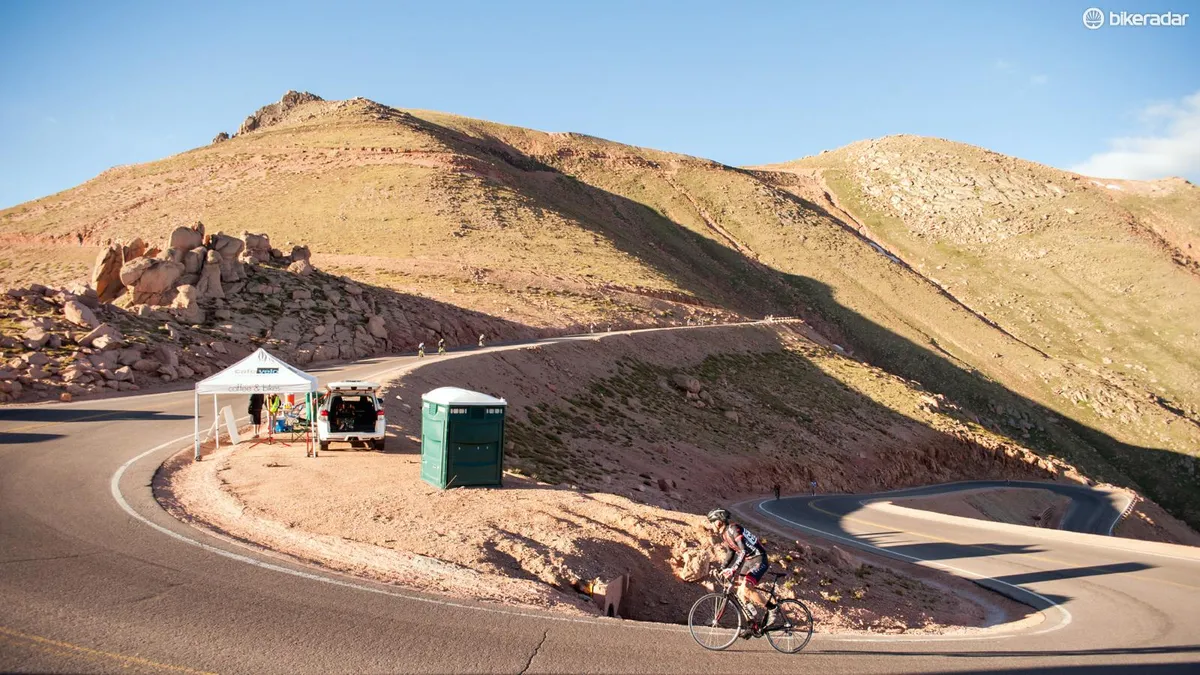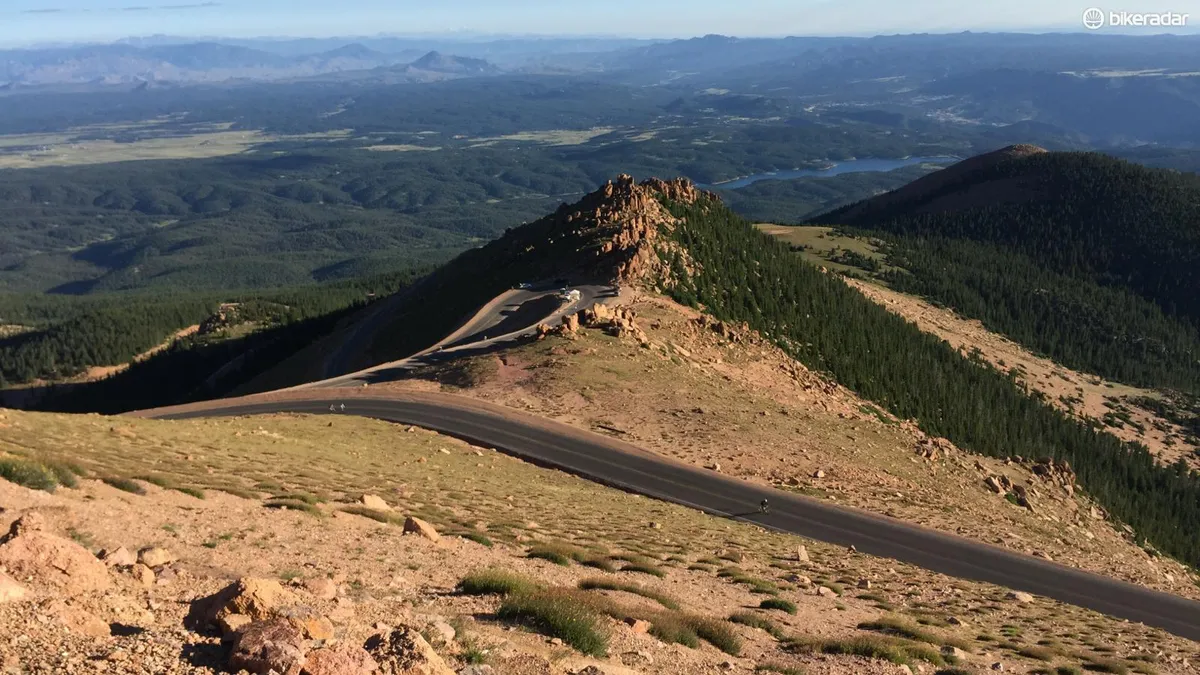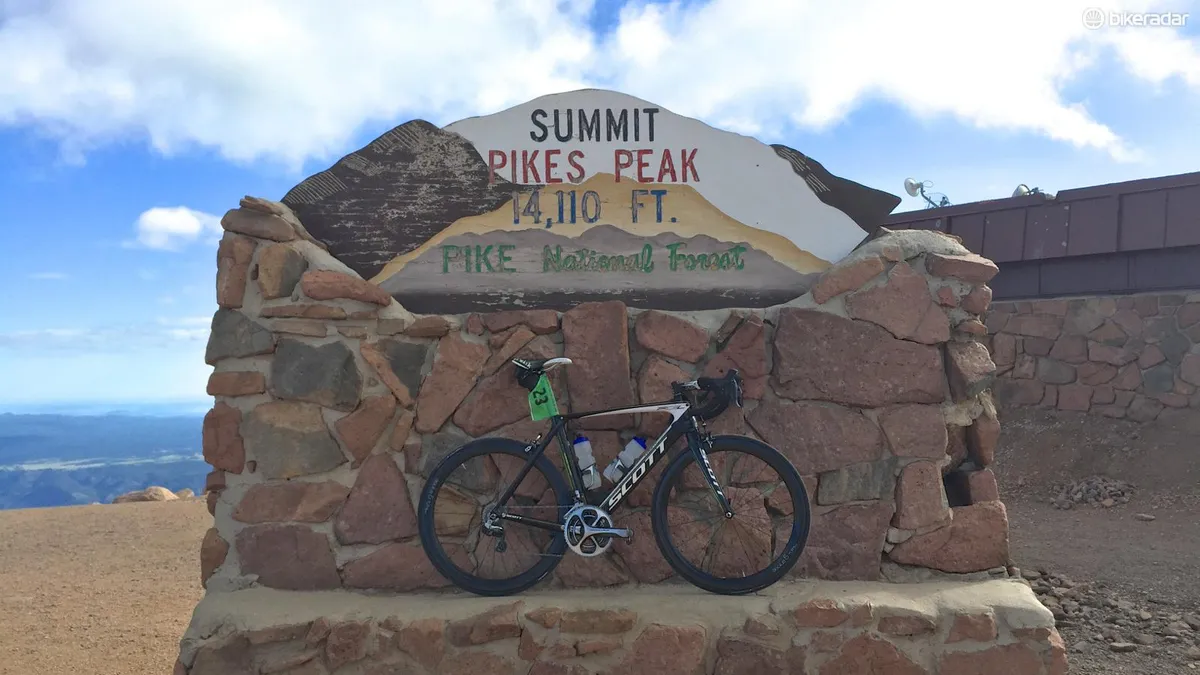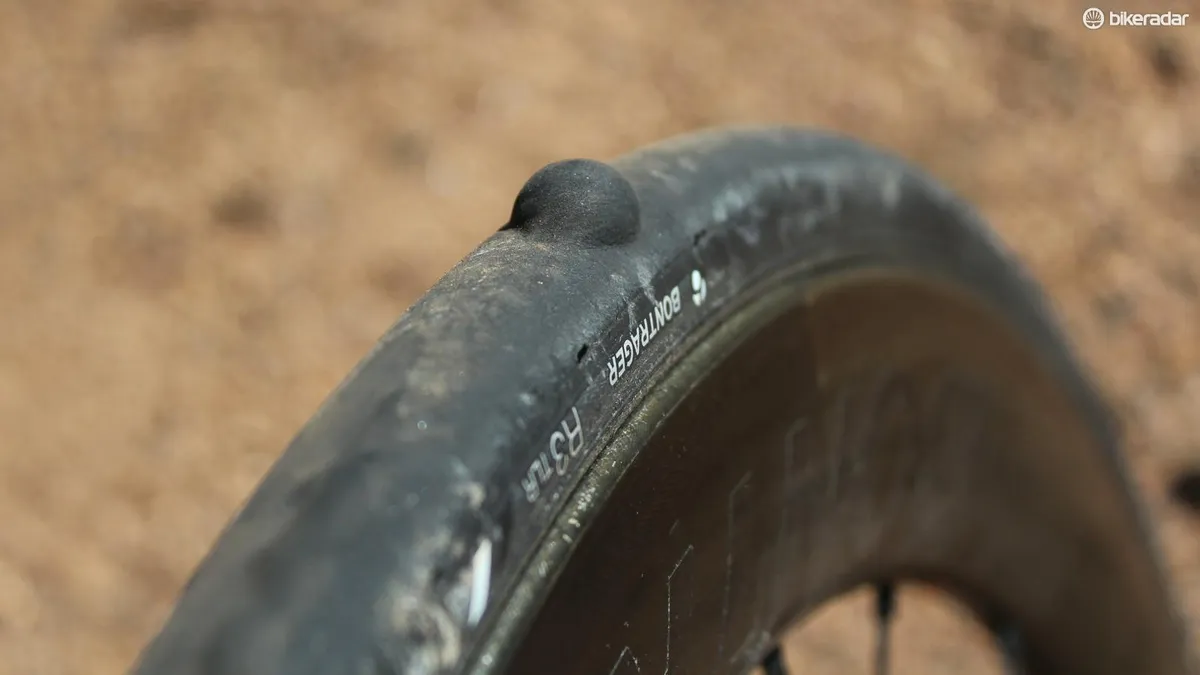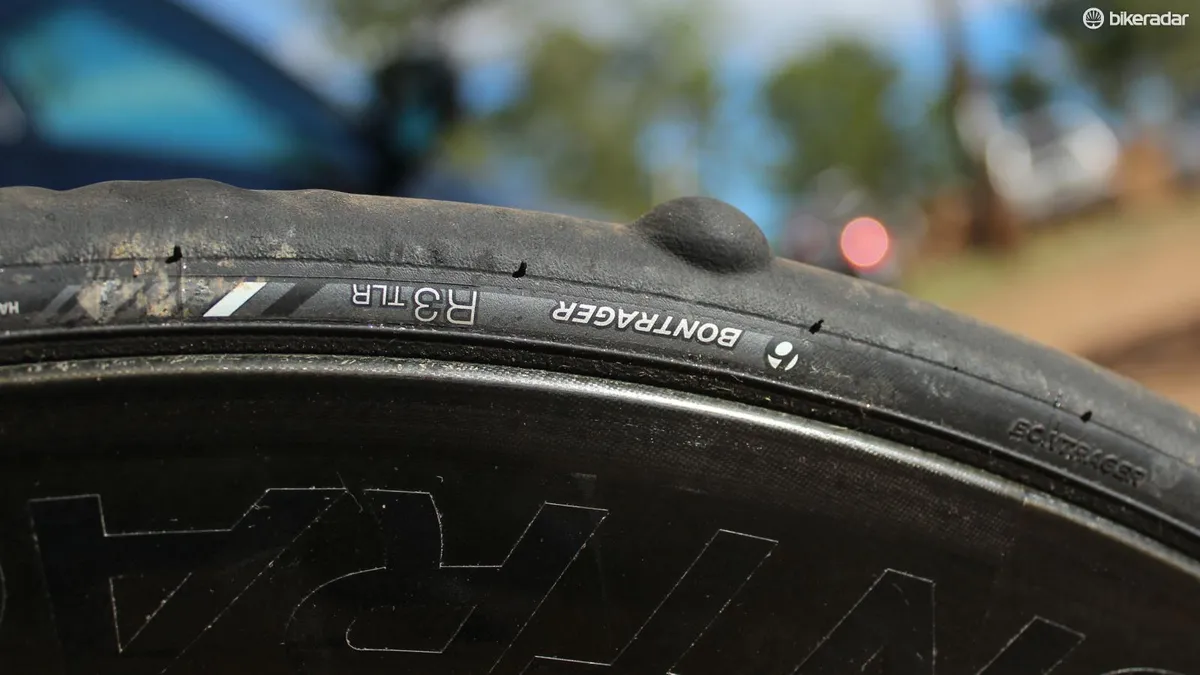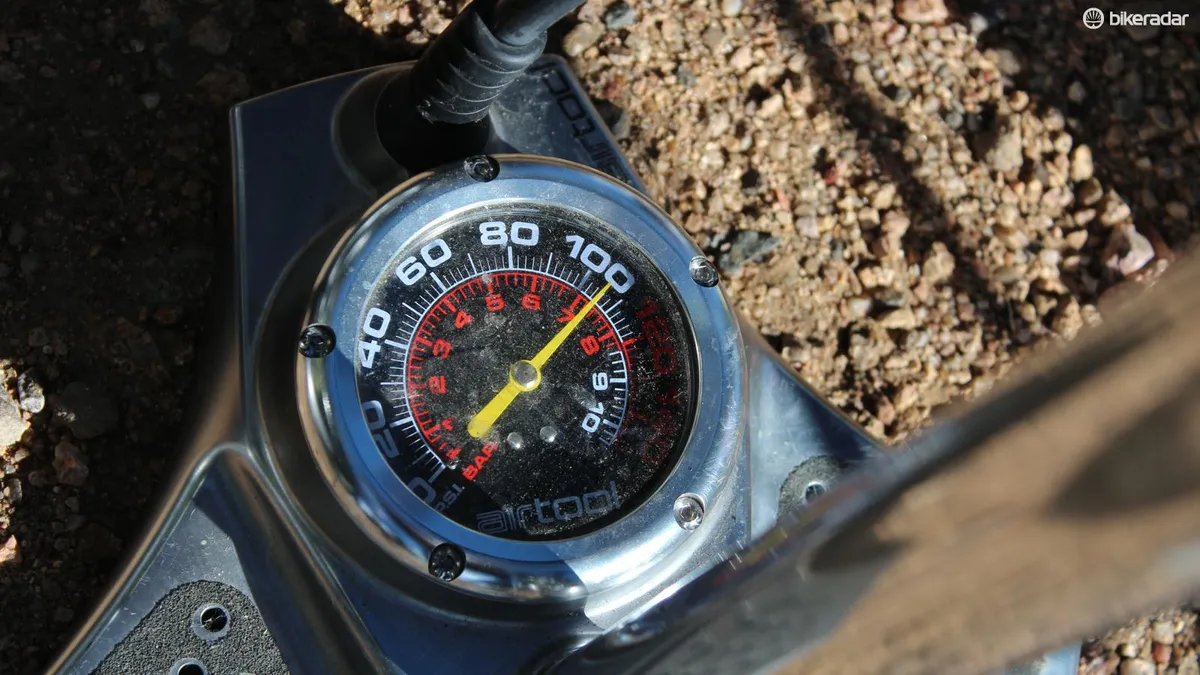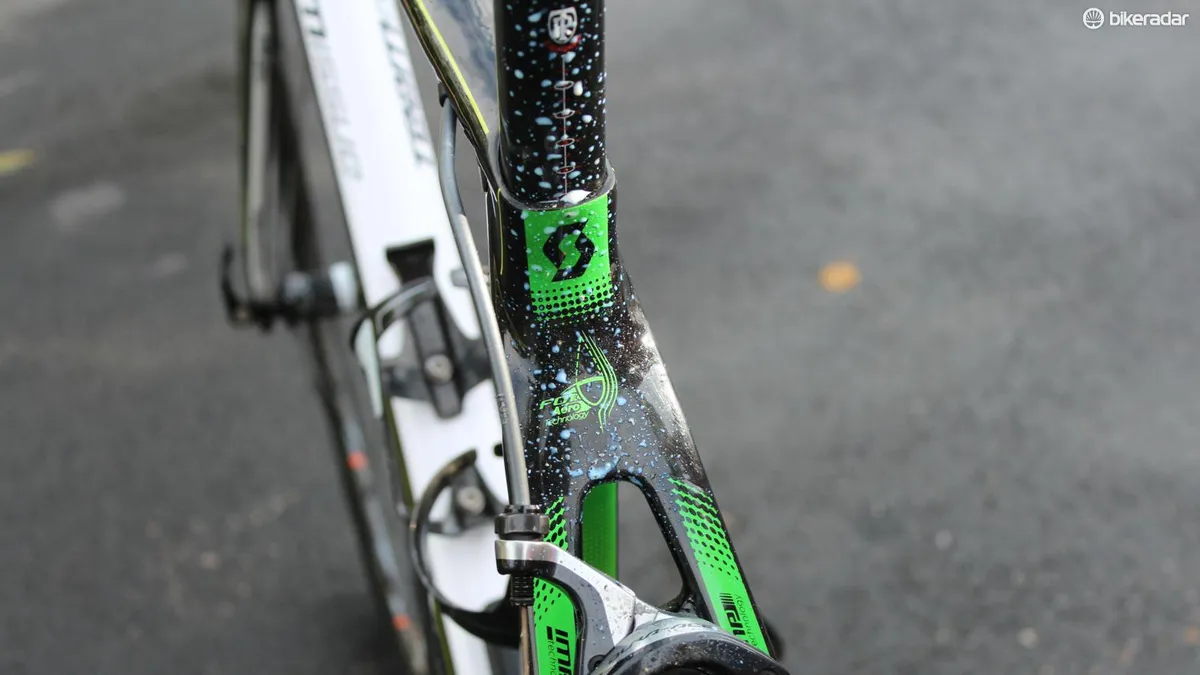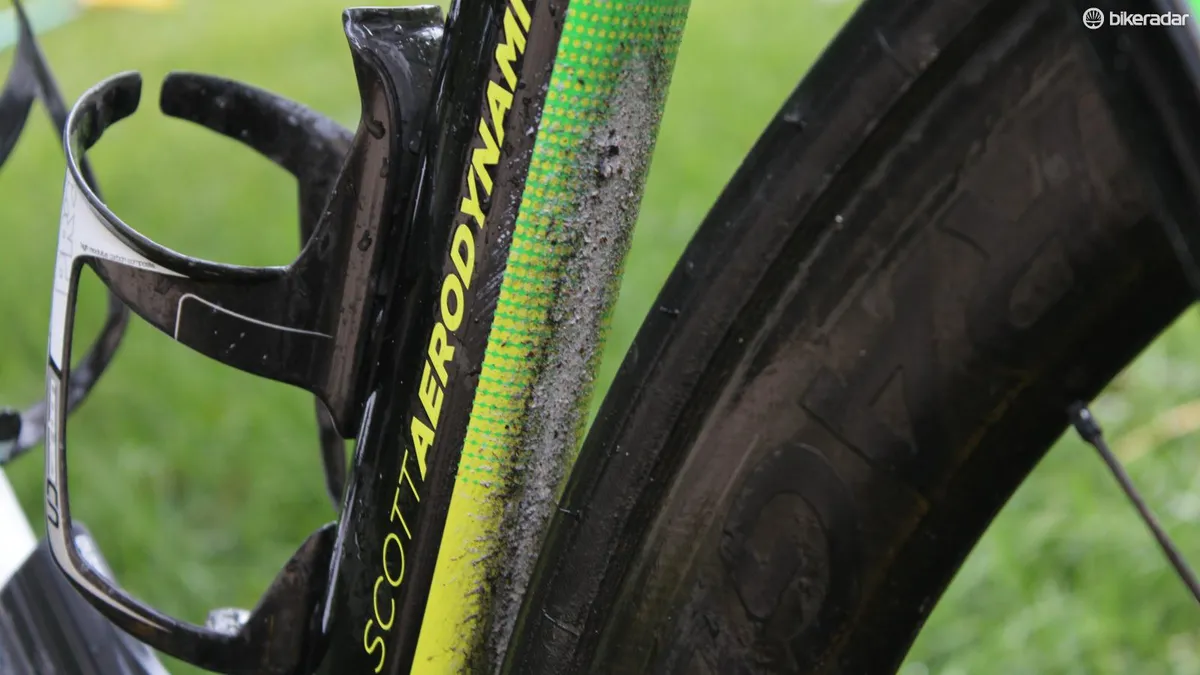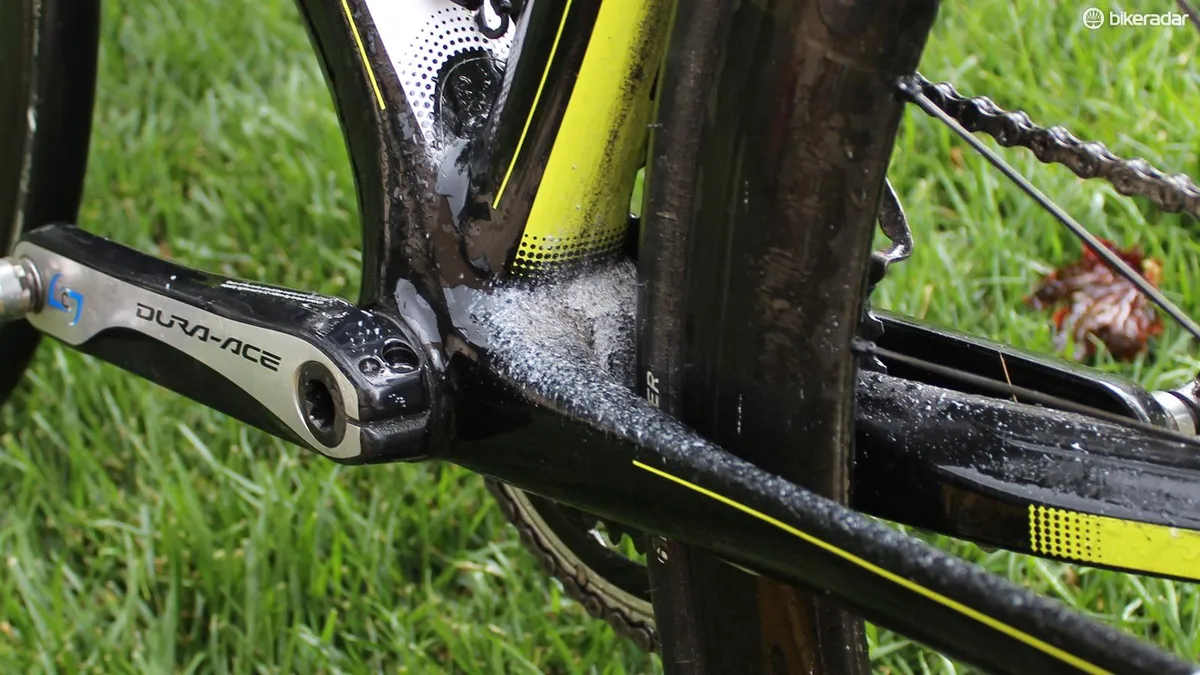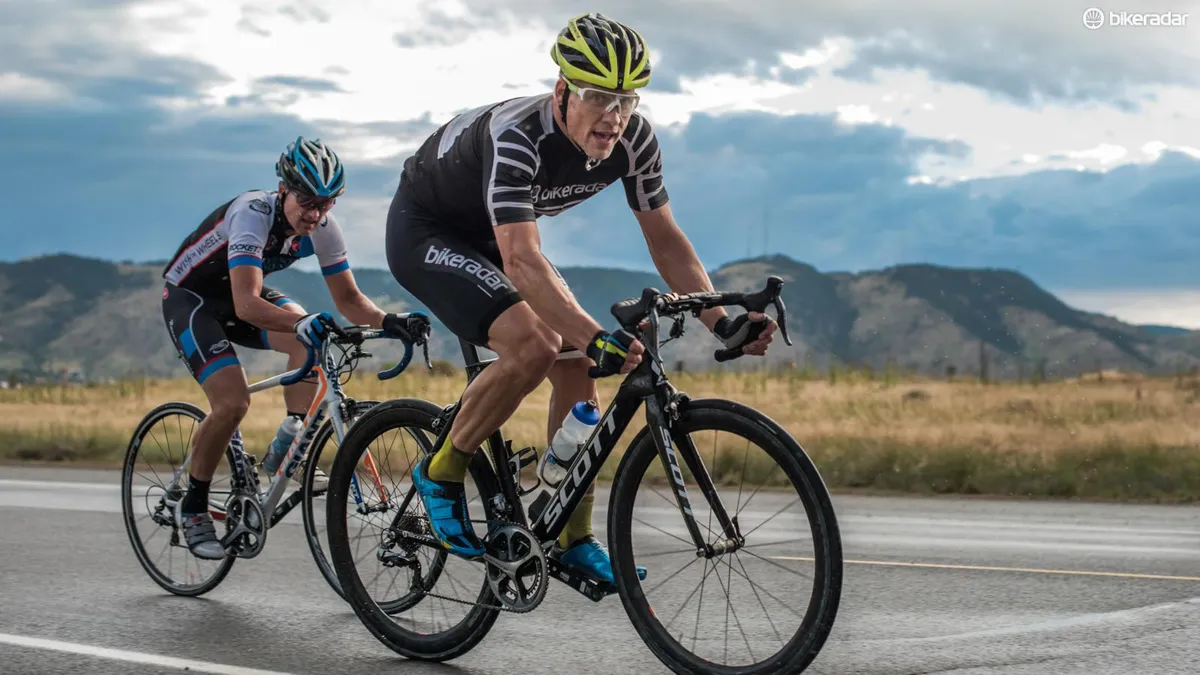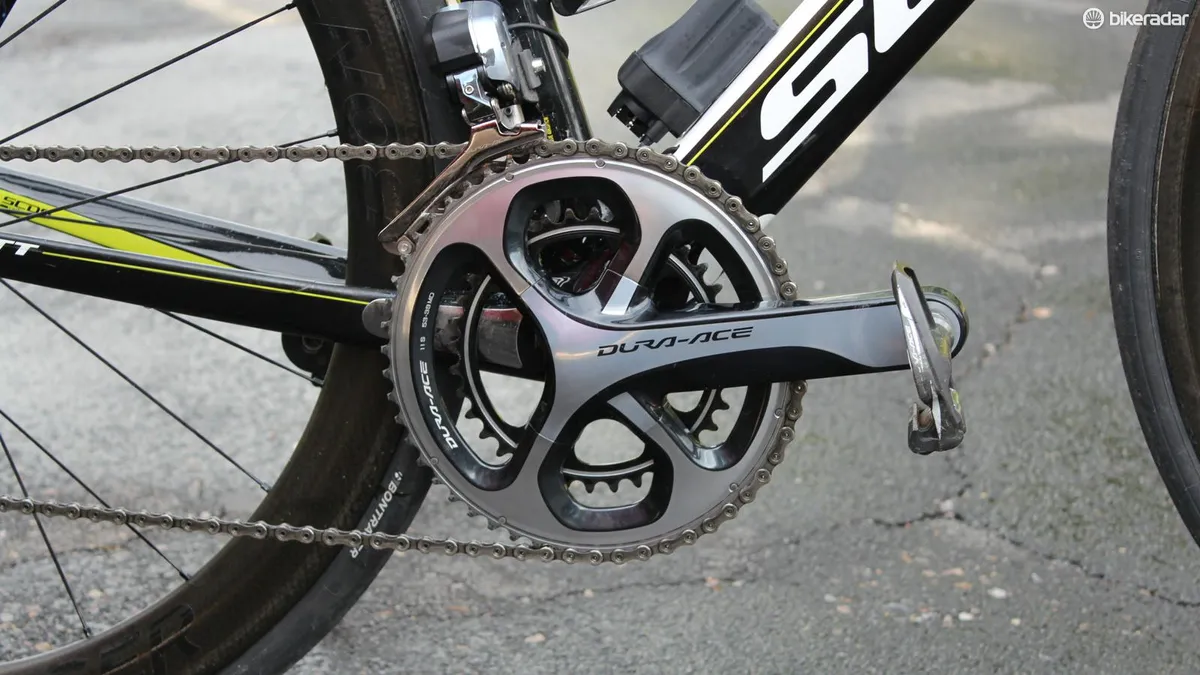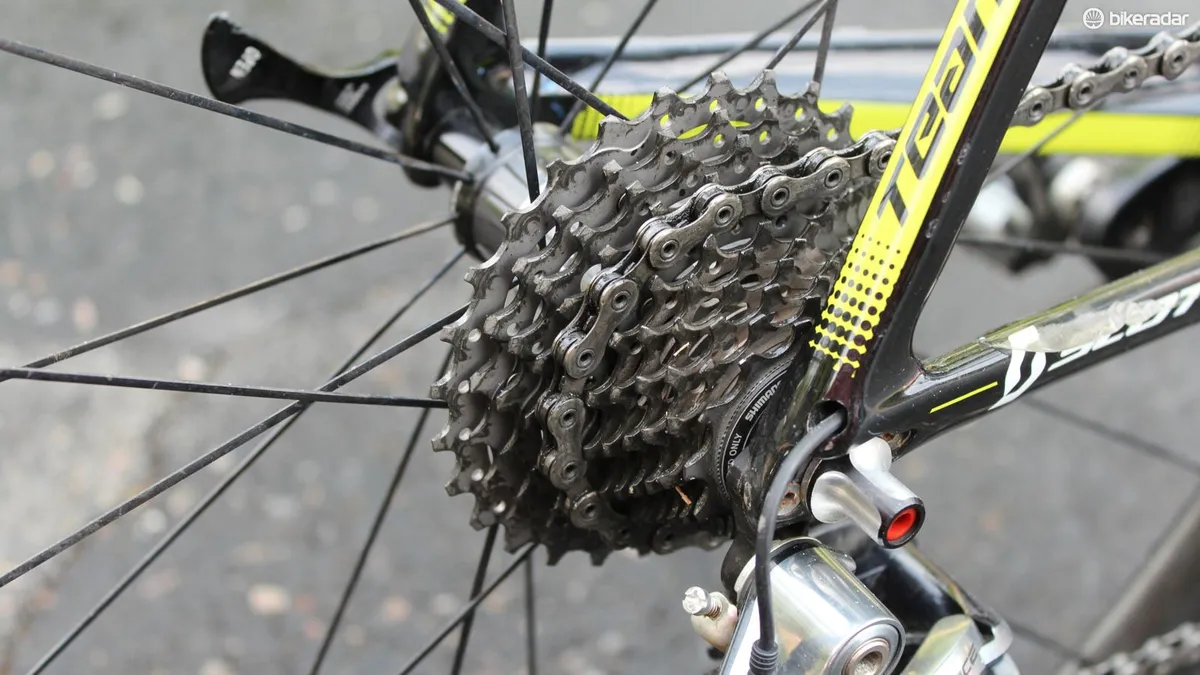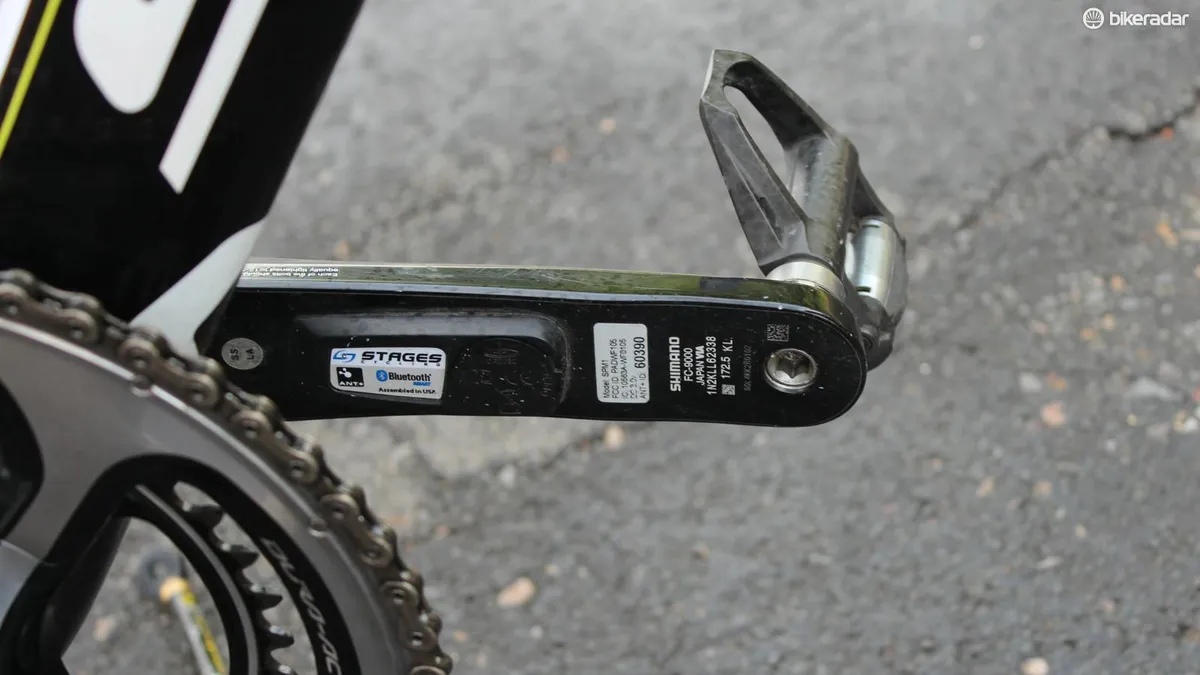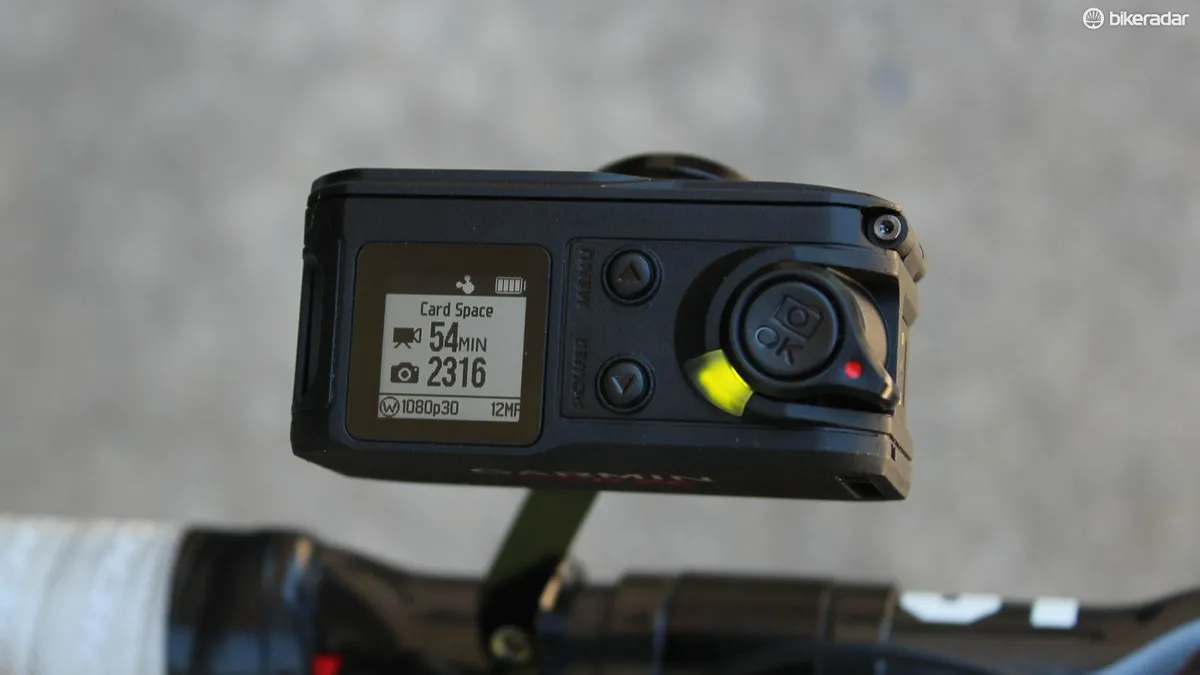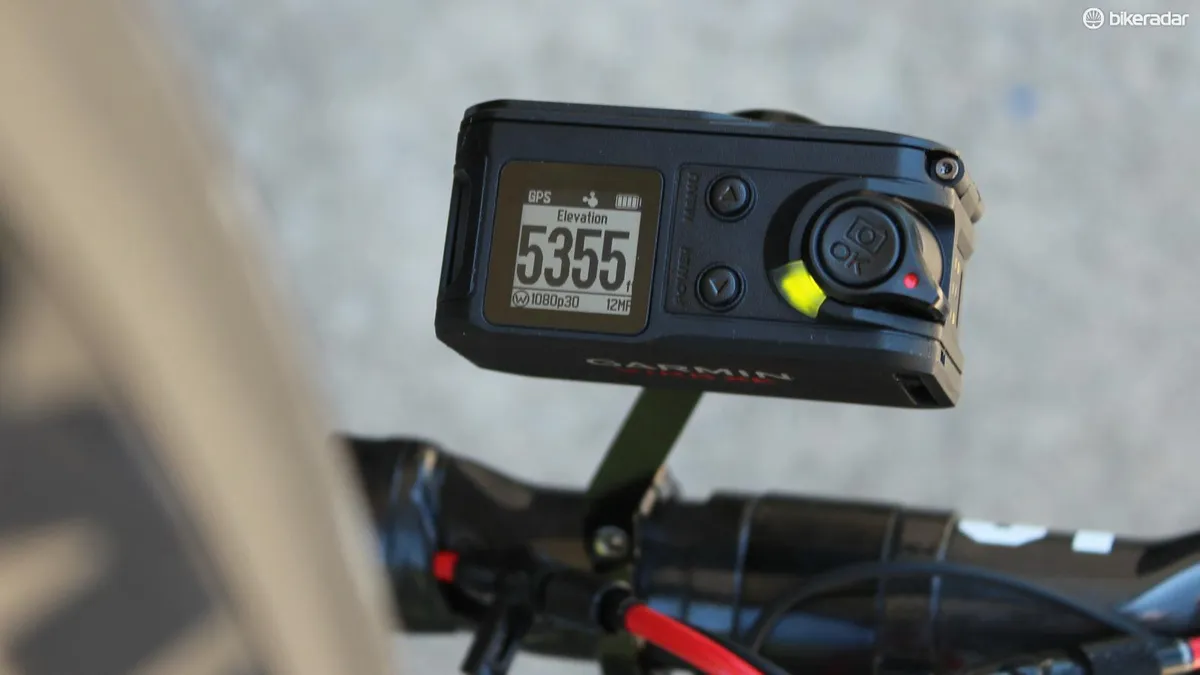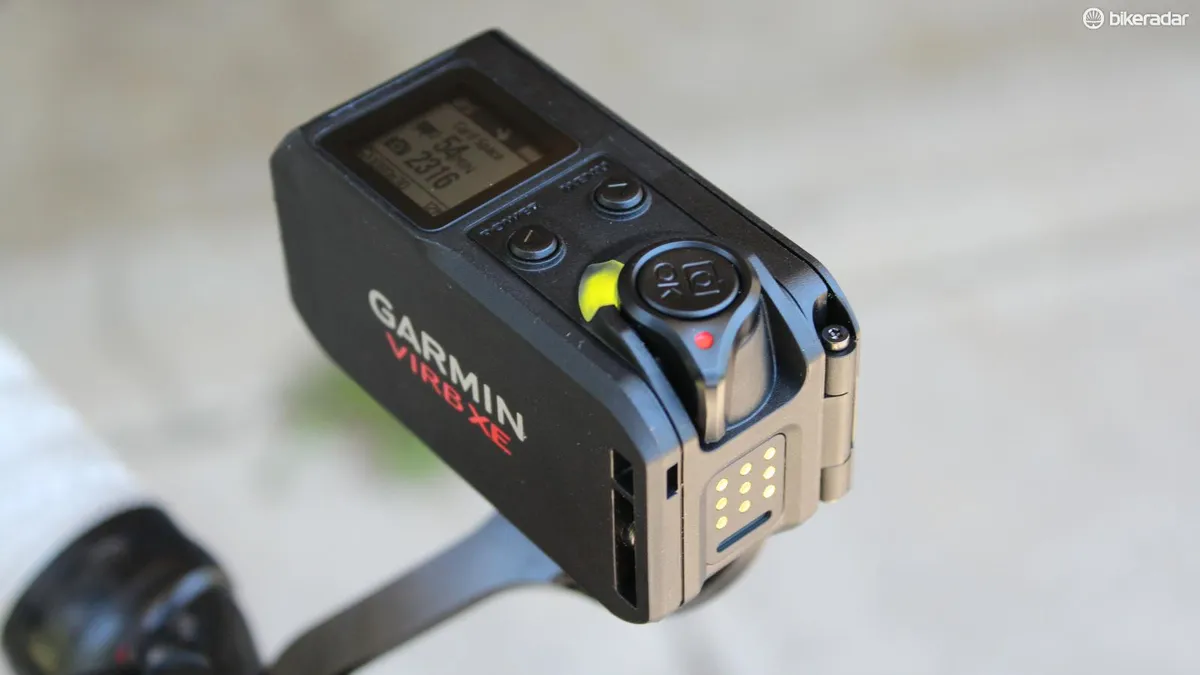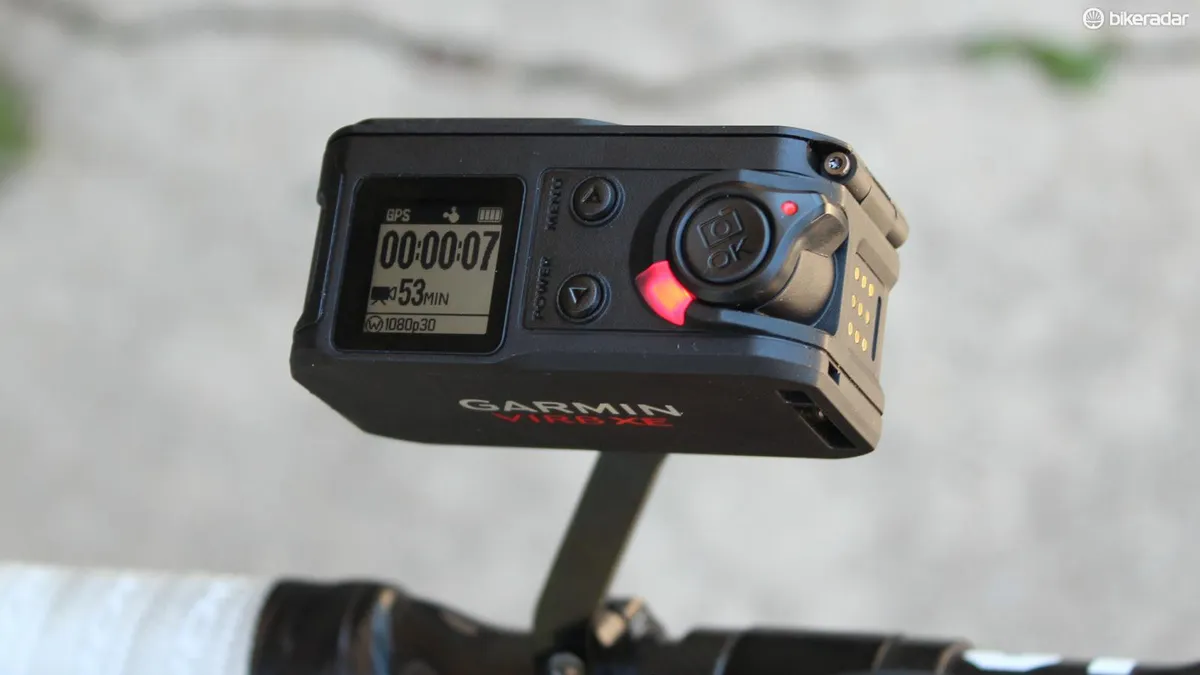Can the same bike and the same set of gearing work well for flat criteriums and a Colorado hill climb up over 14,000 feet? In this Horse for the Course, I put Shimano’s new 9000 crank and its wide acceptability of chainrings to the test on a Scott Foil.
I also tested Bontrager’s new tubeless Aeolus 5 TLR D3 carbon wheels and Garmin’s new Virb XE video camera, which lets you embed power, heart rate, speed and other data in the footage.
Historically, we had two options for cranks and their compatible rings: standard (with a 130mm bolt circle diameter) gave you 53/39, and compact (with a 100mm BCD) gave you 50/34 or 52/36. Shimano’s new crank, however, has its own BCD that works with rings from both ranges. My sweet spot is the 52/36, but I had a 53/39 on the Foil, so I thought I’d try swapping in a 36t ring – and exchanging the 11-25 cassette for a 12-28.
Related reading: What is a compact crank?
In central Colorado, Pikes Peak tops out at 14,115ft / 4,300m. One day each year they close the mountain to cars and the Pikes Peak Hill Climb takes riders up nearly 5,000ft of vertical over 12mi on an average gradient of seven percent.
I have been called many things on a bike, but climber has never been one of them. Would 36/28 be low enough?
- The Courses: Pikes Peak Hill Climb + various run of the mill criteriums like this
- The Horse: 2013 Scott Foil Team with Shimano Dura-Ace Di2, 53/36 and 11-28, Stages power meter, Garmin Edge 1000, Garmin Virb XE video camera, Bontrager Aeolus 5 TLR D3 tubeless wheels — 7.34kg / 16.18lb all in
- The equipment goals: A single setup that works well for two diametrically opposed styles of riding
53/36 on flat criteriums and huge hill climb
A hit for crits
For the criterium portion of this Horse for the Course, I did a downtown race, then a couple of Wednesday night criteriums – including one in the rain. (Note to self: when there’s rain in the forecast, replace the cork pads with the SwissStop pads, you big dummy.)
For the criteriums, the bike and gear generally worked well (wet cork pads notwithstanding). The Foil is notoriously stiff, but with good pavement there’s no problem. The crits were all big-ring affairs, and I loved using the Di2 sprint shifters to fine tune my cadence from the drops.
The shifting at the Di2 lever felt a little vague when inside the noise of the bunch. You can press the lever — still feeling the spring back — without actually shifting if you don’t depress it all the way. I didn’t realize how much I had relied on the sound of the shift to confirm engagement.
The Bontrager Aoelus wheels feel good when cornering and when accelerating. Riding and racing with tubeless is nice — albeit occasionally messy — in that stopping for flats is greatly reduced if not eliminated. The snub-nosed design means crosswinds are not a sketchy, I-wish-I-was-riding-shallower-wheels situation, as air flows predictably across the leading and the trailing sections of the wheel and tyre.
Related reading: Bontrager Aeolus 5 TLR D3 review
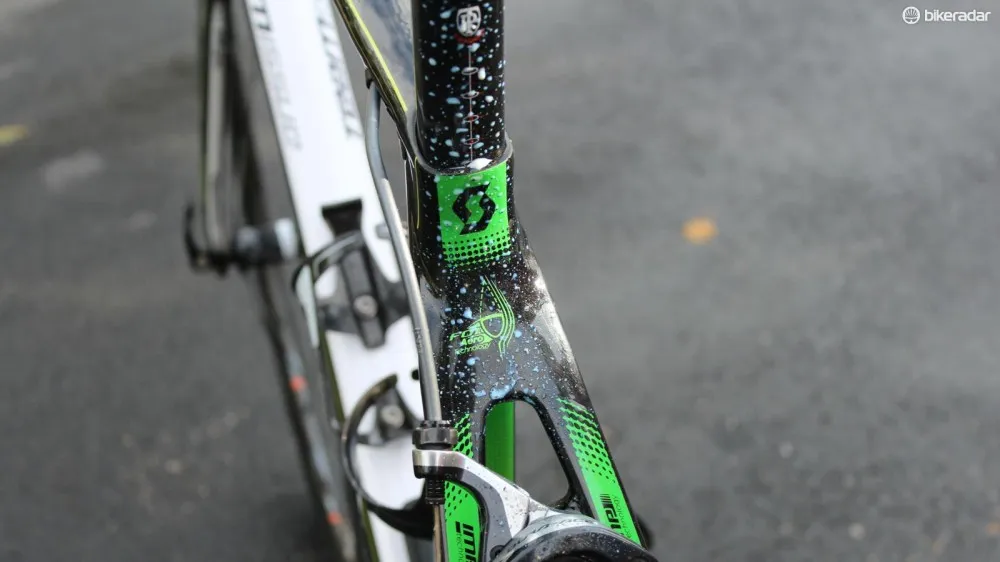
Tubeless sealant does its job, fixing punctures on the fly. You do have to pay the piper, though, as the splatter ain't pretty
The Garmin Virb XE is fun to race with, because you can link your heart rate monitor and power meters into it, and the device itself records speed, elevation, temperature and more. One feature I particularly like is the big switch that turns the unit on and starts recording. This is much easier to use when riding or racing than pressing two GoPro buttons and hoping you held each of them down for the right amount of time, and didn’t just switch the camera to still mode instead.
The Garmin Virb Edit software is fairly straightforward with drop-and-drag functionality, and you can choose a variety of templates for overlaying the real-time data. Check out the video above for examples of how the video and the overlays look.
When filming, it’s key to have someone in front of you. Otherwise, your footage is boring. Having a rider or riders to watch, as well as a frame of reference, makes a huge difference.
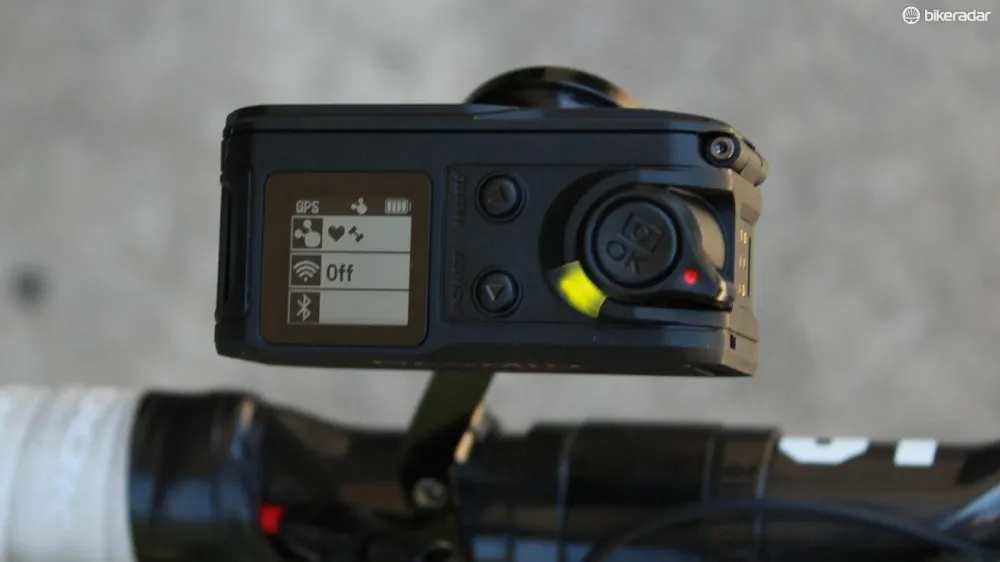
The Garmin Virb XE connects easily with your power meter and heart-rate monitor, and has its own sensors for speed and elevation, the data from which can be incorporated into the video footage graphics
An uphill battle
Pikes Peak was the true test. Pretty much right out of the gate at 9,000ft I was bottomed out in the gear. My cadence for the climb hovered around 65rpm, a good 15rpm or so lower than ideal.
Cadence aside, weight is obviously the big factor when climbing. At 185lb/84kg, I wasn’t exactly a threat to the course record of 1:08:36.
As usual, though, I was just interested in trying to beat my friends. Alas, this was not to be. AnalyticCycling.com has a cool calculator for weight and slope. For the PikesPeak course and my bike-and-body weight, I would have needed to shed 2.7lb / 1.23kg to gain a minute. That’s about the weight of two full water bottles. Well, since my buddy Dave put three minutes into me on the day, there was no sense in going full weight-weenie or riding without a drink.
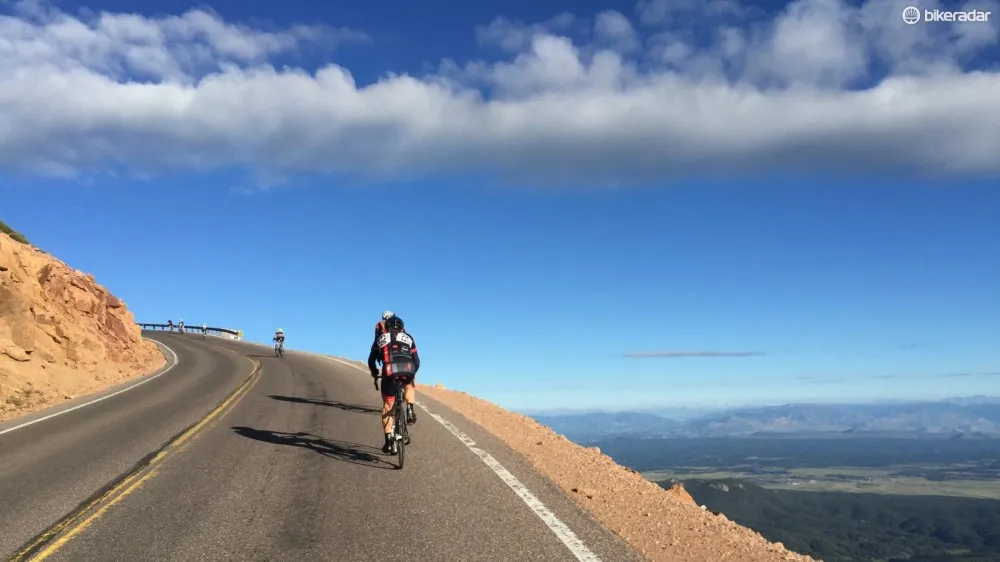
Pikes Peak averages seven percent for 12 miles, up to over 14,000ft
Had I had a lower gear, though, you better believe I would have used it. Especially in the last thousand vertical feet as the air got thin.
A weird thing happened sometime on the way down, as a friend pointed out at the bottom that my tyre had bubbled up like it had the mumps. Evidently some air had escaped the butyl air-retention layer in the tubeless tyre, and it was trying to work itself out through the tread. Bontrager representatives said this was an issue that has since been addressed in manufacturing.
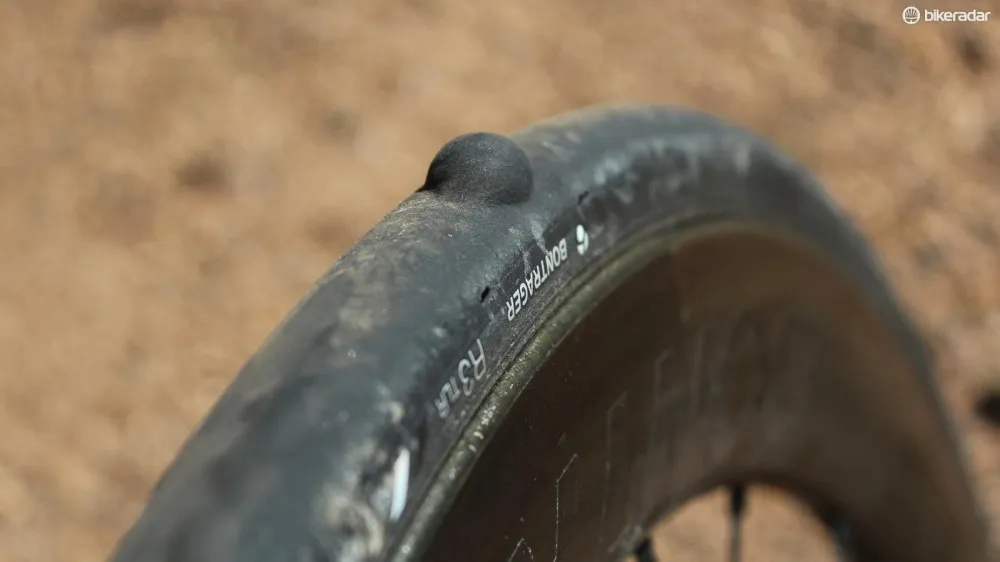
What the?
One horse for two courses?
So, can one bike work well for both crits and a 14er? Well enough, I’d say. The reality is that climbing a 14er is something I’ve done exactly once in my life now, and I’d rather have a bike set up for what I normally ride. Were I to weigh much, much less and consider myself competitive for a hill climb, I would definitely have gone ultralight with all gear and used lower gearing.
Related reading: Guinness record for most climbing in 48 hours (95,623ft / 29,146m) — on a steel bike with Shimano 105!
I am a huge fan of the 36t ring for normal climbs. Although Shimano doesn’t recommend the 53/36 combo, the Di2 front derailleur shifts between the two flawlessly. The only issue really is the larger jump in gears and thus in cadence when you switch from one chainring to the other.
On a bike with 53/39 or 52/36, I normally shift the rear derailleur once at the same time as I shift the front to minimize the change in cadence. With this 53/36, I found myself quickly shifting two or three gears at the cassette for the same reason.
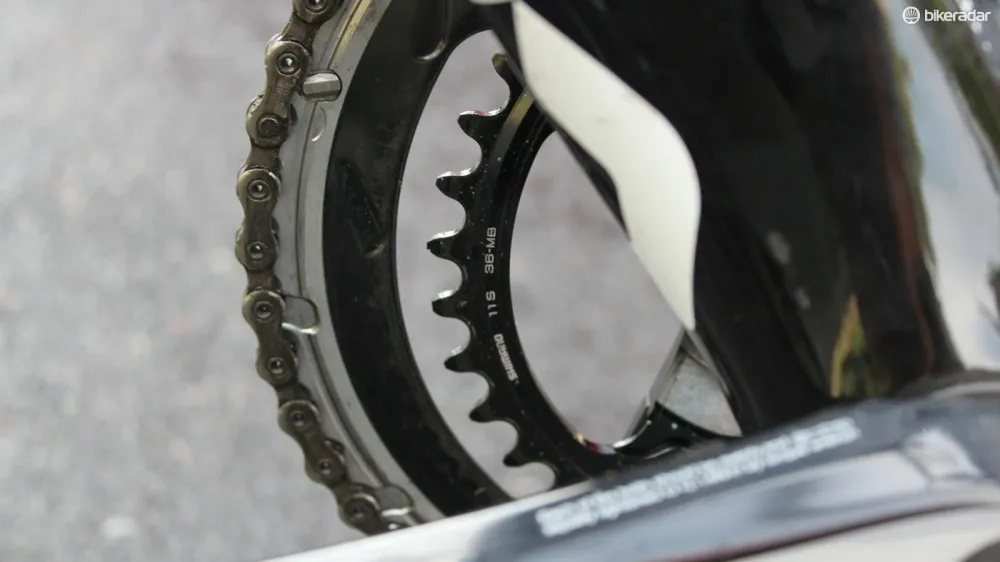
Shimano doesn't recommend the 53/36, but it shifts just fine
As with all gear-selection issues, where you live and how you ride plays a major role in determining what’s ideal. There is a handy gear calculator on BikeCalc.com that lets you compare the ranges and individual gears you can get with various setups. If you are tinkering with your current setup, remember there are limits to what derailleur cages and chain lengths can handle.
If you are doing long climbs or lots of flat riding without a lot of terrain in between, this large jump between 53 and 36 is a non-issue. If you are riding rolling hills or just working back and forth a lot between the rings, the jump in cadence might be annoying.
As a heavier masters rider in Colorado, the 52/36 is spot on for my normal riding. But the next time I tackle a 14er I’m going to see how well Di2 shifts from the big ring down to a 34t small ring…
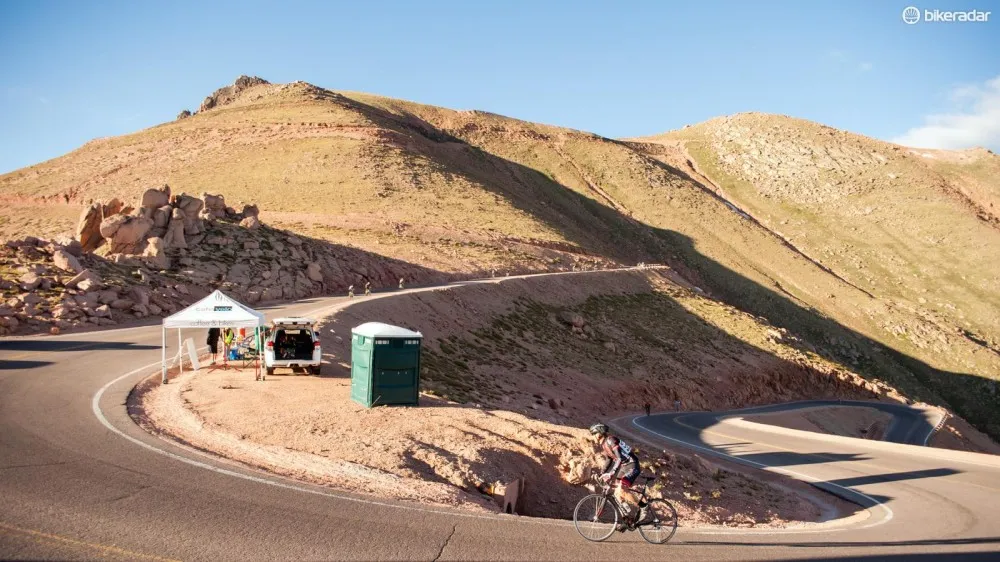
One day a year Pikes Peak closes to cars and cyclists have free rein
